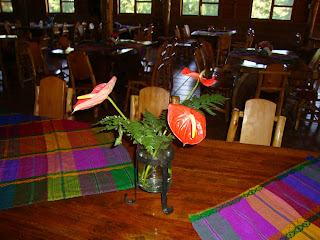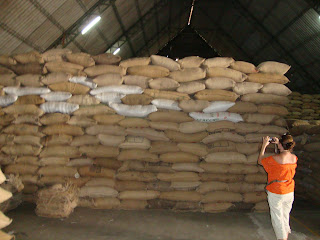Before we move into the blog let's have another history lesson that covers a small part of the civil war and the ultimate peace treaty that was signed. Here is a thought. Is there a peace treaty between waring groups following a civil war or is it called something else? In any case I am sure you understand the subject.
I noted in an earlier blog that you see security guards holding shotguns in front of most stores and businesses in San Salvador. You also see this to a lessor degree in smaller communities and villages. In seeing these guards, I concluded that the area was unsafe and businesses were protected from armed robberies. I was incorrect. The government and the FMLN party sat down with a mediator from Costa Rica and came to a number of agreements that finally ended the war. On the government side, they demanded that the FMLN turn in their weapons. At the time there were about 80 thousand government soldiers. The FMLN told the government that they no longer needed that number of soldiers and they agreed to lower the number of active service men to 20 thousand. The problem then became what to do with 60 thousand men that were out of work. The government formed a security service for the nation and deployed these men around the country to act as security guards for businesses. They felt is was better to give these men jobs rather than leaving them to fend for themselves and possibly cause problems later. They are only allowed shotguns. Riffles and pistols can only be used by the military. You have to wonder if they have any shells for their shotguns. Remember the television show Mayberry? Maybe they are given one bullet and they keep it in their shirt pocket in case they need it.
OK lets move into something that is more interesting and new photos to view.
The first place we visited was a small artist village known for the small miniature clay figures that they make by hand. It is not so much that the size of the clay figures that is interesting but the painting on the figures themselves. They almost need to use a magnifying glass and brushes with a single strand to do the paintings. Sorry but I did not get any photos of the completed figures. Below is one of the many shops where they make these figures. The tools and ovens are very basic and have probably been used much in the same way overs the generations. No sophisticated manufacturing techniques here.



These are photos of the streets and people as we walked around the town. As always, there is a central market. Without exception, you always find a central market where locals buy and sell their goods.


After a long drive, we arrived at another small village where we first had lunch. The hotel owner and operator is from France. He was here visiting in the past and he enjoyed it so much that he stayed and opened up a high class French restaurant and small hotel. Go figure!
This is a wall painted in the entrance to the hotel/restaurant.

These are some photos of the grounds within the hotel and the others with me on the tour.




OK; It is time for a break until tomorrow. One must not allow himself to work too hard down here. It could turn out to become a BAD habit.
Here we are, yet another day in paradise. It rained last night so it is a little cooler today. You take your cooler days one at a time and can only hope that they last more than one day.
On my way back to my boat yesterday, I stopped at a mango tree to pick some fresh mangos and then sat down to eat the freshest mango I have ever eaten. Delicious. This morning I am drinking a glass of fresh papaya juice that was run through a juicer as I watched. EAT YOUR HEART OUT!!!
OK, let's see if I can complete the blog today and send it off before I run out of energy and have to finish tomorrow. I know; It is hard to feel sorry for me!
After having an excellent lunch we walked through to town to see the sites. As I always do, I took a photo of the church at the edge of the center square. The first photo tells all. El Salvador is working hard to get tourist trade built up in their country for the obvious reasons. The U.S. media has everyone convinced that Central America is dangerous. This is far from the truth so they look to people that are down here now to report back to their friends and family that this is a safe place to visit. So tell your friends.

As with all of the colonial towns, homes and businesses are behind these walls. Although the streets are empty, life exists beyond the walls until the evening when everyone comes out to visit and walk around during the cooler temperatures.

Here is something to consider for you daughter when she gets old enough to date. Back in the old days, girls were allowed to visit and talk to boys only if they remained behind these windows while mom stood in the back of the room to watch and listen. Robin, aren't you glad I never though of this?

This is the smaller church in town. I wasn't able to get inside for more photos.

Lazy about town.

Off again down the road to a larger town of Santa Ana. The church here is much larger and I was able to get inside for some photos. Also another building nearby was a government building and theater.



Those of you that may have read about the civil war have heard about the FLMN. They were the the people that fought against the government establishment and were considered communists. Today they play a part within the government and have seats within elected positions. Here they are having a rally to discuss the importance of tourism and what can be done to encourage other countries people to visit. The 8 of us were the only tourists in town. They should have asked us to come on stage so they could show the people what real tourist look like.


Next we are off to find our hotel. We are in the mountains so the air is much cooler. YEA. The hotel is something that you might see up in the woods and forests anywhere in the U.S. Very rustic. The gardens within the property are beautiful and the flowers are some that you only find in the tropics.



I almost forgot to show you how you can find a cheap cab in El Salvador.

Sorry, I didn't finish yesterday. Not because I got lazy but because the internet connection went south and I gave up before somebody died at my hands. :(
Here are some more photos of the grounds around the hotel where we stayed and the restaurant.






On the road again. Next stop was at a coffee processing plant where coffee growers sell their harvest and the plant sends the beans through a long process that takes several weeks that shells, cleans, separates the correct size beans and removes any remaining foreign particles before they are put into lots by grade and sold to retailers. A coffee taster much like a wine taster, goes through the lots and grades them.
The beans are brought to this station first to wash them with water before sending them off to the next stage where beans are sorted by size.


Next they are laid out on this roof where they are dried before they are sent off to the oven where the beans are further dried .


This is the final stage before they are bagged. Beans run along these belts and ladies separate out foriegn material that made it through all of the earlier sorting. Then the beams are bagged and they must remain in these barns for 2-3 months before being shipped to the retailers. Do any of you memember the Lucy show where she is packaging donuts as they run down the belt?


Sorry guys, more flowers. These are on the grounds of the coffee place. Before I forget, I did buys some beans which I have yet to have. I will let you know how the coffee tasted.



Next stop was an artisan community. Here you see cloth that is being made and a video to watch the process. No fancy machine here. You don't have to oil the machine just feed it beer.


How do you like my hat?

Photo taken from inside a local church.

I forget one more item about coffee. Coffee plants are grown under shade trees. The reason I am told is be obtain a better yield. In addithion, heavy winds can blow the beans off of the vines. Here you see coffee plants that are hiden under trees and surrounded by wind brakes also from grown trees. Coffee as well as most crops are grown on on hills or mountains. There is very little flat ground in this country for growing. You even see corn crops that are growing on a steep slope.

One more photo of the inside of a church.

Tell me the truth. Does this look like a happy horse?

Finally. I took this photo as we drove back to the marina. You may recall that I noted in an earlier blog that El Salvador has more volcanic mountains per square mile that any other country in the world. Here is an example why this is so.

Well that is it for now. Finished until my next adventure. I am starting to make plans for going south to Panama and lining up people that wish to join me. So far I have one line handler with a second looking for a way to also make it for the trip through the canal. I can use two more able body men or women to fill up the required four line handlers.
Until next time be safe out there. :)
1 comment:
The hill crops look amazing!
Post a Comment